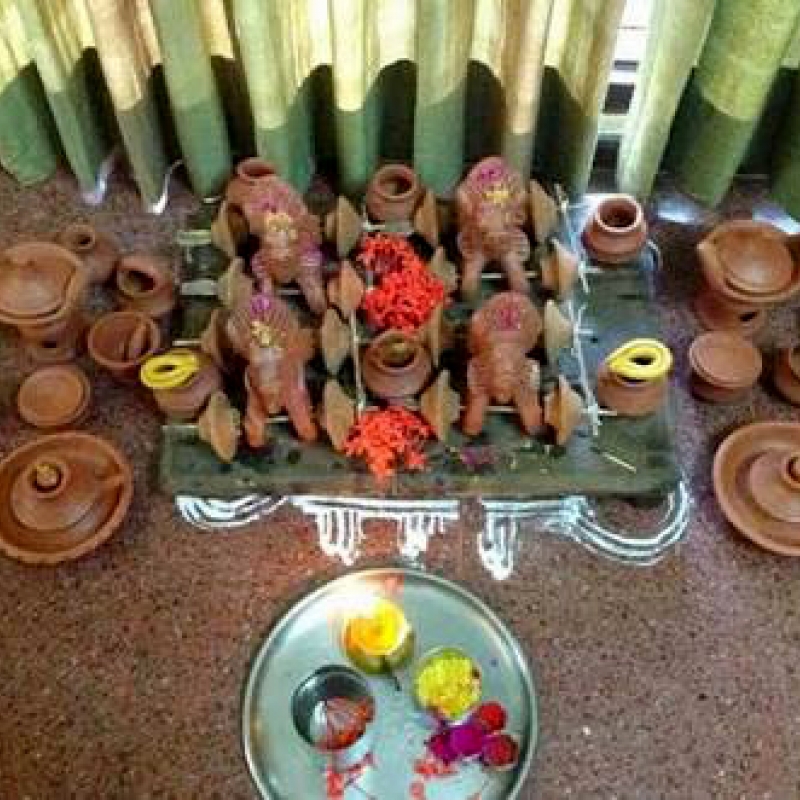Festivals have been an intrinsic part of our society for time immemorial. These festivals become opportunity for people of various communities to come together in celebration, which in turn reflects the nature of continuity in our respective cultures. One is aware that the connection shared between human and their social communes with nature are often reflected in their festivals, folklores, arts and other cultural or ritualistic activities. Similar to many ancient communities, one also finds that the ‘Adivasis’ of Bastar share a deep bond with their environment. In fact, their gods and goddesses–ancestral deities and culture are deeply derived from the flora and fauna, the natural and supernatural, that surrounds them. One also finds that various festivals celebrated across different seasons are derived from the practices rooted in nature. For instance, Chherchera, Amakhavni, Navakhani are few among the many festivals, that celebrate the fruit of nature.
Agricultural festivals of monsoon celebrate the pastoral life. Chhattisgarh, which is also known as ‘dhan ka katora’ or ‘bowl of paddy’ has earned its title due to the deep relationship between labour and nurture. We further find, that this relationship between labouring and nurturing is best reflected in the practices of cultivation. Hence, agricultural festivals are opportunities to celebrate the fruits of labour, impossible without a deep connection with nature. Thus, each process in agriculture i.e. ploughing, sowing, planting, reaping of crops and finally, harvesting are marked by festive celebrations. The life of Gond communities, for instance, are sustained by tilling of soil and thus, agricultural activities and practices are found to be deeply embedded in the Gond culture. Rituals throughout the festive celebrations are directed towards offering gratitude to gods and deities, since natural and supernatural energies are considered integral to the processes of cultivation. The sequence in which these festivals are arranged have a deeper relationship with the life cycle of communities.
We find that during the Kharif period, agricultural festivals start with Akti, the day when the seeds are sown– people come together to pray for good harvest and celebrate Savnahi or Beej Pando. A few days later, when the seedlings begin to appear on the surface- rituals for Bhojli are performed to offer prayers for good health of the crops. As the crops become green and healthy, Hareli is celebrated among cultivators across Bastar, Chhattisgarh. Although, Hareli is considered to be the pratham tyohar (a prominent festival) in Chhattisgarh, it is only celebrated when seeds have germinated and seedlings have become visibly taller. The festival, based on the calculations of planets (grahas) is celebrated after the land has been ploughed and seeds have been sown. Beyond this no agricultural tools are used on the land. Hence, it is a festival of finally cleaning and worshipping the agricultural tools that have finished their work for the season.
Pola on the other hand, is an event of offering gratitude to the bail (Ox) and his labour on the field. The Ox is a farmer’s most important labouring asset, that must be honoured and worshipped. Another important festival among the farming communities is the festival of Navakhani, which is celebrated in the month of bhadrapad, according to the Hindu calendar. Navakhani means ‘consuming the new crop’. It is celebrated after the new yield of rice crop is harvested. The new rice grains are ceremonially cooked and offered to the village deity, clan deities and ancestors on the ninth day of the month of bhadrapad. The auspicious celebration of the new crop starts on the seventh day of the month of bhadrapad, when the Baiga (healer and ritual head) of the village offers new rice to the Adivasi god Devgudiyo. These three festivals can be said to be the most important festivals during the season of kharif across the farming communities of Chhattisgarh. However, this essay will seek to elaborate on the ritual practices of the two most important monsoon festivals of Bastar- Hareli and Pola.
Hareli
Hareli is celebrated patchily in Chhattisgarh. Although, it began as an agricultural festival of the Adivasis, today different communities of Chhattisgarh worship different deities as they celebrate Hareli. As shared above, Hareli is a festival celebrated in the kharif season (i.e., the agricultural season during autumn starting in the month of July or asadh according to the Hindu calendar). It is celebrated on the day of the new moon (Amavasya) of the month of Saavan (also called Shravan Amavasya). Hareli is colloquially derived from a Hindi word haryali, meaning ‘greenery’. Thus, Hareli is a celebration, as well as gratitude for the greenery on earth. We come to understand that Hareli is celebrated for two reasons; first, to protect livestock and the people from diseases, bad omens, and witchcraft; second, to express gratitude to the tools, which were used in the process of cultivation (after rice transplantation is over)- tools which play an integral role in ensuring that the earth remains fecund.
Stories of Hareli
Preparations for Hareli begins a day before it is celebrated. The Raut or Yadav community plays an imminent role in it. The shepherds of the village (more often belonging to the Raut community), traditionally observe a fast on this day and bring back medicinal herbs or plants from the forest. They carry herbs or plants like shatawar (Asparagus), gondli (wild onion), Dashmool kanda (dotto kand) and so on, to prepare a medicinal concoction for good health and immunity of people. This concoction is cooked through the night in a new earthen pot. The next morning, people of the village collect to worship Sheetla mata (the guardian deity of the village) with oil and turmeric. They then walk to the gauthan where the oxen are collected.
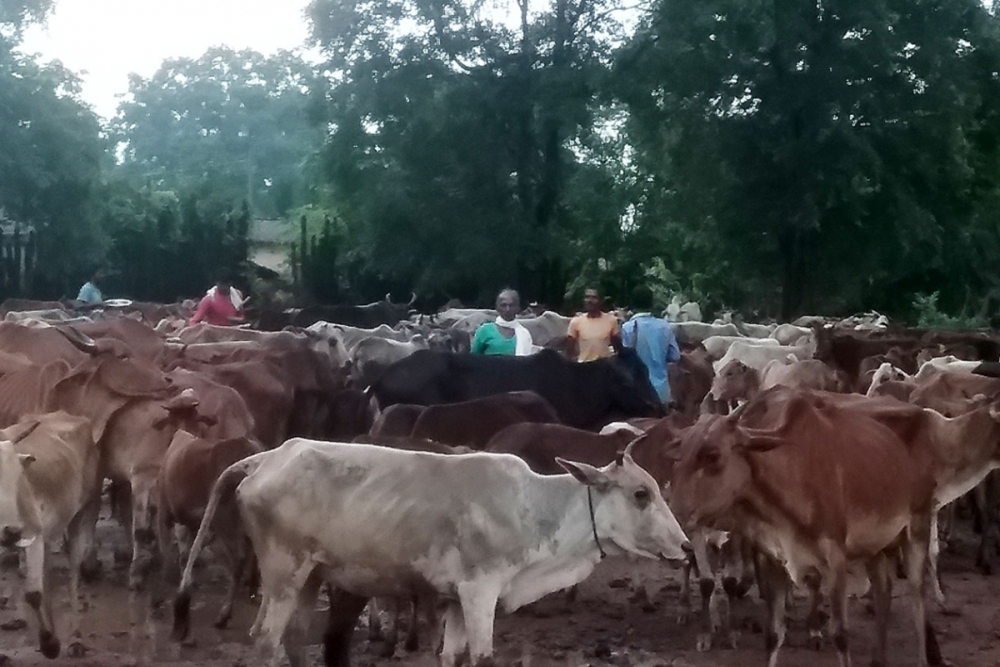
Figure 1: Cattles are Collected at Gauthan for Hareli
It is ensured, that the gauthan is cleaned by the people before the morning rituals start. At the gauthan, the Baiga (the village healer, who can also be a ritual head in the village) worships the animal deity, Sahada Deo. The concoction that has been prepared by the shepherd and londi are distributed among the residents by the village ritual head.
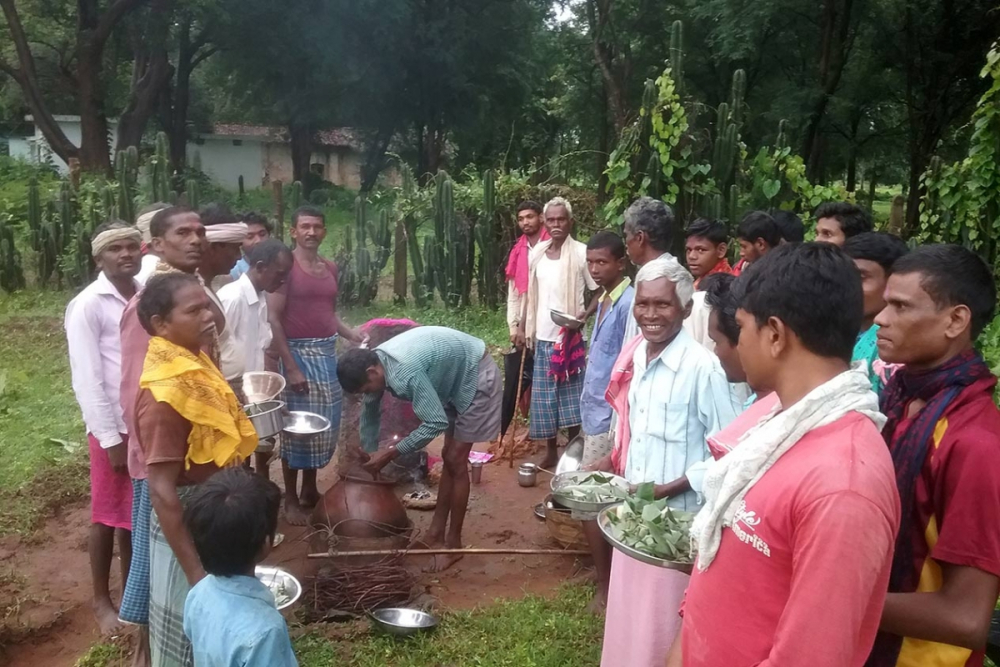
Figure 2: Medicinal Concoction being Distributed and People holding londi in Plates after Sahada Deo is Worshiped
The residents of the village offer paddy, pulses, and other grains to the shepherd and Baiga as a gesture of gratitude. After receiving the medicinal concoction, people gather together to worship ancestral deities. The londi or bati which are small circular balls made of kneaded wheat flour is offered to the oxen. The londi is covered with castor leaf and a small pocket of salt is kept by its side. It is believed that londi and castor leaf has medicinal properties, which protects livestock from diseases. In the afternoon, people wash and clean their agriculture tools used in the process of farming (like the hoe, spade, shovel, trowel, axe etc.) and, they also clean their houses and area surrounding it. These tools are placed on an elevated platform made of red soil and, worshipped. Murum or red soil is used to repair broken roads and pathways in the village. The gauthan and cow sheds at home are also repaired. Thus, on this occasion, londi in the castor leaf given to oxen and agricultural tool worship, are the highlights of the occasion. Perhaps, a way of thanks-giving for the labour they do.
The diversity of cultural practices in Chhattisgarh gives us other reasons of celebrating Hareli. In some places, the goddess of crop ‘Kutki Dai’ is worshipped and prayed for good harvest. The Baiga goes to the lakra and minjhari fields to bring them in bundles. He then visits every household in the village and ties the woven bundles of minjhari grains and lakra fruits to their roofs and, in return is offered grains. In some places, branches of Bhelwa tree or Neem tree are placed in the middle fields. The entrance doors of the houses are adorned by hanging branches of the neem tree. These trees, as we know, have herbal properties, that purifies the air, repels insects that may cause harm, and help in preventing several diseases. It is believed that from the month of asadh to saavan, witch-craft takes place. Neem tree and Bhelwa tree are also used for protection against bad omens. In few places, cow dung is also used to remain protected against black magic or witch-craft. Liquidated form of dung is used to draw image of human at the entrance of the house. At some places, a chain of human images is drawn.
Among the Baiga community, Hareli plays an important role. On the day of Hareli, members of the Baiga community educate their disciples about medicinal properties of herbs, plants, and trees. They continue to teach their disciples for the next 15 days and, this goes on till rishi panchami. On rishi panchami, they test their disciples, and if they pass, they can practice as a baiga (healer). It is believed that during this time, the disciples have the opportunity to learn many things about medicinal herbs, plants, and trees because of their easy availability during the monsoon season.
Gedi
Gedi (stilts) is an important part of Hareli. Particularly, children are often found playing this. The act of walking on bamboo sticks is called ‘gedi’. It is a game in which children mount on bamboo sticks and walk around the fields. It is believed, that the stilts have a magical significance i.e., it encourages the crops to grow. Gedi is mostly made of bamboo trees; it is also made of gotiya or sarai wood, with six feet height. Two wooden sticks are used and, two feet from the ground foot rests are made of hollow pieces of char wood or bamboo. These foot rests are called ditto-palk in Gondi. The hollow char wood or bamboo is filled with pebbles, which creates a sound when the stilt is used. The use of gedi is allowed only for a couple of months during the rains, from the day of Hareli till the day of Navakhani. After this day using stilts is considered a taboo. Hill Maria tribe do not use gedi every fourth year, it is considered a taboo to do so. Nowadays, this game is played only in some parts of Bastar. The culture of playing gedi is increasingly lost. To revive the culture several races and competitions are being organised by panchayats and Pradhans.
Feast
On the auspicious occasion of Hareli, most of the traditional food are prepared with rice flour, like chila roti, muthiya, angarkar roti, chousera roti etc. Also, many varieties of green vegetables are prepared like kanda bhaji, kochai patta, chowlai bhaji, bohar bhaji etc. Bore bassi is an important meal prepared of rice on this day. Many varieties of sweets are also prepared with rice like doodh fara. Few Adivasi communities also brew mahua (local alcohol) for offerings and consumption.
Pola Festival
Pola is celebrated shortly after Hareli. Pola is celebrated when rice grains start germinating. It falls on the day of the Pithori Amavasya (new moon day) in the month of Bhadon. This is also called Kushopatini Amavasya. This is celebrated after the second process of removing weeds (nindai-kodai) of kharif crops. The festival has two important aspects, first it is indebted to the bullocks and second, a belief is widely held that during Pola, the goddess Annapurna is impregnated. A festival centred on the celebration of gratitude towards the labouring animal in the field reflects the beauty of human-non human relationship.
It is also believed that on this day, as goddess Annapurna is impregnated, the rice plants are filled with milk, that later become grains. Therefore, on the day of Pola no one goes to the field for work. Similar to Hareli, Pola is also celebrated differently among the various farming communities across the region. In some areas, few rituals are performed at night by the eldest married male member of the family. Late in the night, they go to their respective fields to worship the god Bhaishasur and goddess Bai Rao. The rituals performed at night are performed to impregnate the crops. Many cite that, it is due to this reason that this ritual is performed only by the married male members of a household. During the ritual animals are also sacrificed. In the present times, however, hens are sacrificed more often due to the ease in their availability and affordability. There is a belief that fertility of the seed grain is reinforced by the blessings of gods, as the blood of the sacrificed animal is sprinkled over it. During the months of asadh to saavan animals are not to be sacrificed because these are known as months of nurturing. It is only in the month of Bhadon, that sacrificing of animals begin during the festivals. At some places, the Baiga and few important male members of the village visit each worship area at night and eat the prasad (devotional offerings) there. No one is allowed to carry the prasad back to their houses. Furthermore, a man with a pregnant wife is forbidden to perform the ritual and worship the deities.
At certain places (particularly in Maharashtra), Pola is also known as Bail-Pola where nandi-dev, considered as an important devotee of Shiva, thus, oxen are worshipped on this occasion. In some places, it is also believed that it was on this day, that Krishna was attacked by a demon Polasur, sent by Kansa to kill the child. Eventually, Krishna killed the demon. On the other hand, the Gonds of Bastar consider Bhaisasur to be their god, thus, they worship bulls and oxen.
The day starts with installing a clay sculpture of an oxen, often considered to represent Nandi, which is the main idol worshiped during the ceremony.

Figure 3: Nandi being worshipped on Pola
Along with it, various clay toys bought from the market are placed. Terracotta toys are a speciality of Chhattisgarhi art. Terracotta toys like jata, pot, many utensils and oxen idols are worshipped. These rituals are performed by women. Among the Gonds, first, Bada Dev (also called pen) is offered dhan ke baal (rice panicles). The toy utensils are filled with snacks like thetri and khurmi. When the rituals for the day begins, men, women, children have different roles to perform. Children are given toys to play after worship and men decorate the oxen. In some places, celebrations are marked by decorating oxen with ornaments. Usually, the rope tied on the bulls for agricultural purposes are untied on the day before Pola. While in other places, Oxen are coated with oil and turmeric paste and later cleansed. They are further decorated with ornaments and in the evening the Oxen-races are organized. Children play with clay idols of Nandi bull fitted with wheels of clay or wood. Young girls play with chukiya, jata, bartan (utensils)- while boys can be seen running around with their wood or clay Oxen. Children take Pora (Pola- the clay toy) with them in the field in the evening, and break it; this ritual is called Pora Patkana. They take one toy each and break them in the field, after which they continue to play games such as the Surpati, Kabbadi and Kho-Kho in the field.
Feast and market
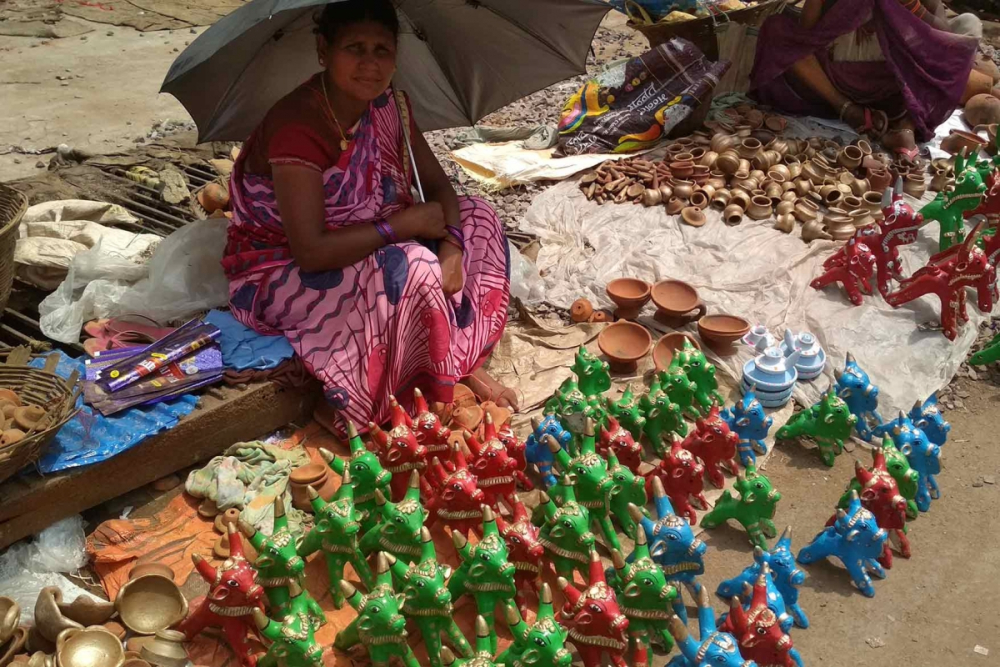
Figure 4: Market for Pola Festival
Pola brings colours to the market. The market becomes a profusion of decorative items like Oxen, bullock idols, toys, bullock head-gear and other ornaments for the bulls. Festivals are incomplete without the special reference to food.
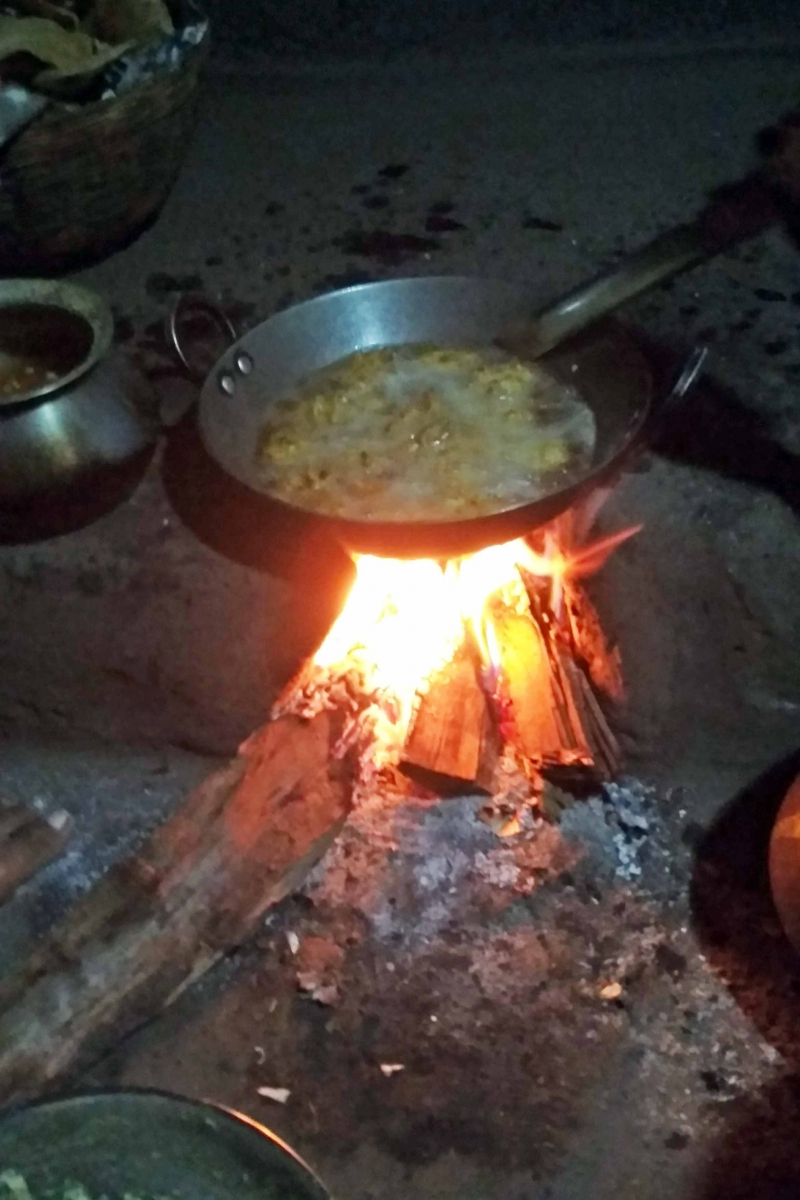
Figure 5: Bada being Prepared for the Feast on Pola
On this occasion, gudha-chila, anarsa, sohari, chausela, thethri, khurmi, bada etc. are prepared for offerings and as a ritual for celebrating the festival.
Conclusion
In the month of Saavan, when the farmers have toiled and worked hard- Hareli and Pola– both become occasions to celebrate the labour of cultivation. While Navakhani– is a festival that celebrates the fruits of labor; Hareli and Pola celebrate the act of labour. On these two days gratitude is offered by farming communities to his tools, land, nature, and animals. It is a celebration, an acknowledgement of the integral role played by various non-human actors, without whom the agricultural activities would cease to exist.
Acknowledgement
An acknowledgement remains important to Shri Govardhan Mandavi for his contribution to this article. Shri Mandavi is a peasant, rigorously active in reclaiming the identity and culture of Gond Adivasis. His important inputs and detailed understanding of Gond life-worlds has made this article possible.
References
Elwin, V. (1944). 28. Stilt-Walking Among the Murias of Bastar State. Man, 44, 38-41.
Sinha, R. K. (1981). A Note on the Nature-Man-Spirit Complex of a Tribe (Pando)'. Nature-Mani-Spirit Complex in Tribal India, Delhi: Concept, 69-115.
"https://naidunia.jagran.com/chhattisgarh/mahasmund-hareli-festival-celebrated-with-gaiety-148728"
"http://www.indiafellow.org/blog/2018/01/bail-pola-a-way-of-celebrating-the-man-animal-relationship/"
https://naidunia.jagran.com/spiritual/vrat-tyohar-such-coincidence-pola-festival-celebreted-on-somvati-amavasya-1285507
http://beautyspotsofindia.com/hareli-festival/
https://www.indianetzone.com/55/hareli_festival.htm
This content has been created as part of a project commissioned by the Directorate of Culture and Archaeology, Government of Chhattisgarh, to document the cultural and natural heritage of the state of Chhattisgarh.
